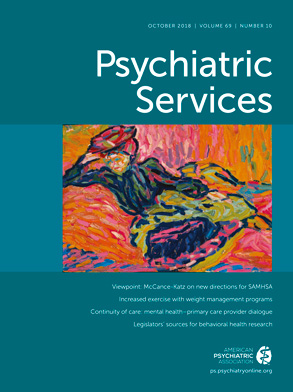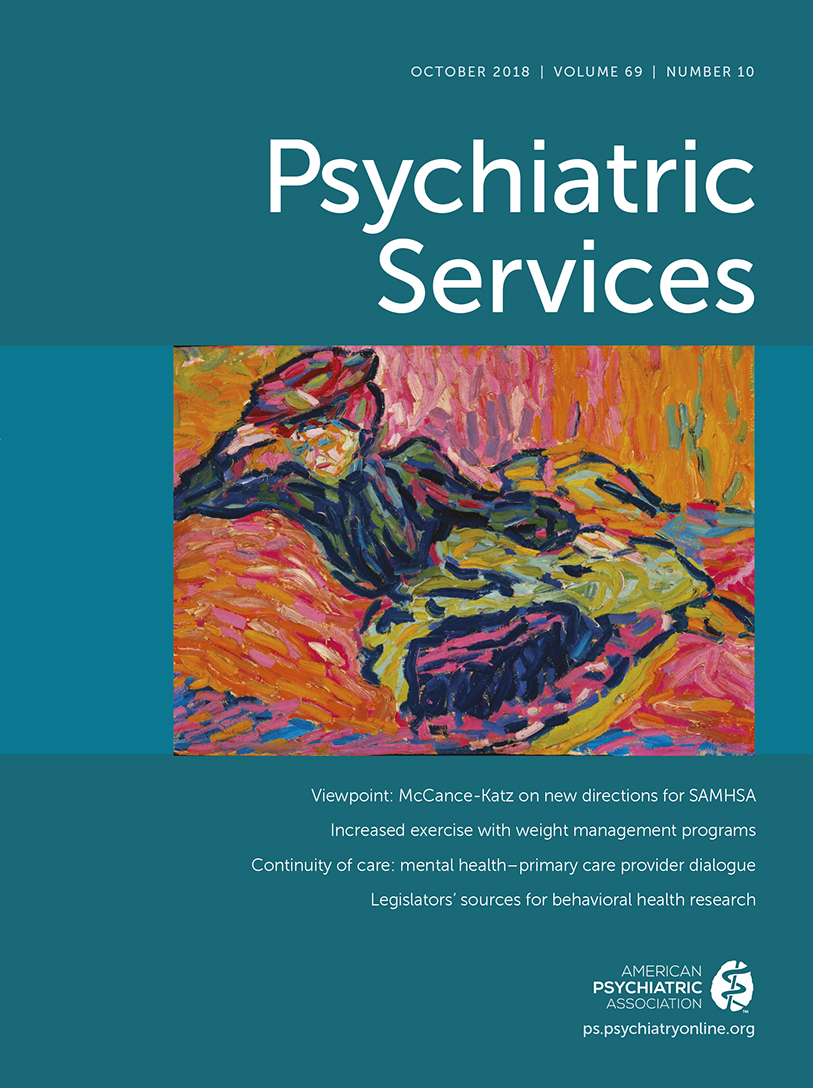Financing mental health care is a growing worldwide challenge, given the mounting total costs of mental illness. The global costs of mental illness in U.S. dollars are expected to rise from $2.5 trillion in 2010 to $6 trillion in 2030 (
1). Over the same period, direct health costs linked to the treatment of mental illnesses in highly developed countries are expected to rise from $536 trillion to an estimated $1.3 billion. This increase has substantial consequences for national health care systems. Many countries will be compelled to reform their reimbursement policies in order to improve the cost-efficiency of care for the treatment of mental illness. This should be especially true for countries that already spend a large share of their gross domestic product (GDP) to finance health expenditures. In the United States and Switzerland, for example, 17.1% and 12.2%, respectively, of GDP was spent on health care in 2016 (
2). TARPSY, the new system for reimbursement of psychiatric inpatient care introduced in Switzerland at the beginning of 2018, may offer interesting insights for countries faced with the task of reforming their reimbursement policies.
Tariff-Based Remuneration
Switzerland is a federal directorial republic consisting of 26 administrative subdivisions, or “cantons,” that partially finance public and private psychiatric hospitals (
3). The cantons cover most (55%) of the costs for medically indicated psychiatric inpatient treatment delivered by these facilities, with the remainder (45%) covered by private health insurers. Patients themselves pay a relatively small fraction of the hospitalization fees, but they are mandated to acquire health insurance from competing private companies. Until 2017, the reimbursement of inpatient psychiatric hospitalization was based on per diem rates. A provider received the same amount of money per day for all patients, independent of the patients’ diagnosis, severity of illness, or symptoms.
With the introduction of TARPSY in 2018, Switzerland switched to a service-oriented remuneration system. This was accomplished in accordance with the Swiss Health Insurance Act, which was approved by the Swiss Federal Parliament in 2007. The law institutes the implementation of service-oriented, lump sum, and nationally standardized remuneration systems for the reimbursement of all inpatient treatment. The task of developing and maintaining such tariff systems was assigned to SwissDRG, Inc., a nonprofit corporation founded by the cantons, insurers, and care providers for this very purpose.
All Swiss psychiatric hospitals are required to provide SwissDRG, Inc., with data on the costs per inpatient stay and a routinely collected standardized data set called “Medical Statistics of Hospitals.” The data set contains coded diagnoses, treatment details, and sociodemographic variables for each inpatient stay. Additionally, the hospitals must complete and record the results of the Health of the Nation Outcome Scales (HoNOS) and the Health of the Nation Outcomes Scales for Children and Adolescents (HoNOSCA) for every adult and child patient, respectively (
4). In 2014 and 2015, Swiss hospitals provided data for approximately 75% of psychiatric hospitalizations that took place in those years. SwissDRG, Inc., validated the data at the patient level. About 65% of the delivered data—representing 50% of total psychiatric hospitalizations—passed the plausibility checks and were used for the development of the first version of TARPSY. The average patient stayed 30 days in a psychiatric hospital and cost $768 (762 Swiss francs) in U.S. dollars per day, including facility fees. Two percent of patients were children or adolescents, 83% were between ages 18 and 64, and 15% were ages 65 or older.
Based on these data, SwissDRG, Inc., developed a classification system known as the “medical grouper logic” for TARPSY that first classifies the patients depending on their main diagnosis in 10 base psychiatric cost groups (PCGs). These cost groups correspond to the nine clinical groups defined by the main diagnostic categories found in the
ICD-10 (F0 to F9), plus an additional group for delirium treatment. Because patients with an identical main diagnosis may have varying symptoms and severity, they may also receive different treatment and incur different costs. SwissDRG, Inc., therefore analyzed the potential of all available patient-related variables to explain differences in resource use. This analysis identified the secondary diagnosis, age, and symptom intensity as such cost dividers. The preliminary basis for the determination of symptom intensity was three HoNOS and HoNOSCA items, namely those measuring the level of aggression, the tendency to self-harm, and the additional physical illnesses and disabilities. Overall, these items allowed SwissDRG, Inc., to further differentiate the 10 base PCGs into 23 PCGs, making the tariff structure more homogeneous in terms of clinical relevance and cost (
5).
According to the Swiss Health Insurance Act, the new financing system of inpatient care should be based on lump sum fees, generally on per case flat rates where a flat amount is paid for each case in a given cost group. Yet this is a difficult undertaking in a psychiatric setting in which the individual length of stay and, therefore, the cost of an inpatient stay in a given PCG are hard to predict. Indeed, the length of stay for a PCG varies considerably, and the observed average daily costs decrease with the duration of stay. For these reasons, SwissDRG, Inc., abstained from computing per case flat rates for the remuneration of psychiatric inpatient treatment. Instead it approximated the observed declining pattern of the average costs per day with daily allowances that reflect the average daily cost of treatment. These allowances are then transformed in relative and nondimensional cost weights, constituting the nationwide tariff structure. These cost weights multiplied by the length of stay of a given case yield the final tariff for that case. The actual remuneration in Swiss francs corresponds to the product of the final tariff and the base rate, an amount in Swiss francs that each hospital negotiates individually with insurers and that is approved by the cantons.
For example, a psychiatric case assigned to the PCG called “TP27B depressive disorders, age >17 years” with a length of stay of 30 days has a cost weight of 1.019 and a final tariff of 30.570 (1.019 × 30 days) (
6). The hospital’s remuneration in Swiss francs corresponds to the product of 30.570 and the negotiated base rate. As already mentioned, the cost weights are dimensionless and defined on the national level, whereas the base rate and therefore the remuneration in full can vary between hospitals. Although TARPSY is a nationally standardized remuneration system, its remuneration structure hence allows it to account for regional and structural differences between hospitals.
One of the central elements of TARPSY is its adaptive structure. SwissDRG, Inc., devised it as a learning system that can be continually improved on the basis of insights from newly acquired data. For instance, there is a significant potential to enhance the tariff system in terms of its orientation to various services. Care providers have defined new procedural codes for treatments classified by the Swiss Classification of Health Intervention as involving high consumption of resources—such as complex care, intensive care, and one-to-one care. By documenting and coding these interventions as well as other treatment-related variables in the routine data sets, hospitals will provide SwissDRG, Inc., with data that can allow for further differentiation of the tariff structure.
Another aspect of TARPSY that ensures flexible and service-oriented development is the option to separately remunerate expensive treatments or medicines (e.g., depot medication) and to define additional payments for nonpsychiatric services delivered during a patient’s psychiatric hospitalization, such as hemodialysis. These features should contribute to continual improvement and refinement of TARPSY, making the PCGs more homogeneous in terms of clinical relevance and cost while keeping its application simple.
Criticism of TARPSY
Remuneration systems such as TARPSY have been criticized for increasing economization of the mental health care system, leading to a reduced quality of the services rendered (
7). However, evidence for such a trend is missing. For instance, since the introduction of per case flat rates for somatic care in Switzerland in 2012, no systematic decrease in the quality of the provided services has been observed. This is certainly also due to the work of the Swiss National Association for Quality Development in Hospitals and Clinics (ANQ), which continuously monitors the nation’s hospitals and compares the quality of services they provide.
Another criticism concerns declining cost weights in TARPSY. Health care providers fear that this will lead to early discharges and higher readmission rates. Yet a study of Swiss data did not find any negative relationship between the introduction of a remuneration system with declining daily rates and early readmission (
8). It is also important to recall that the declining pattern of the cost weights in TARPSY simply reflects the observed pattern in the average daily costs. SwissDRG, Inc., did not introduce any element in the new tariff structure to encourage hospitals to reduce the duration of psychiatric hospitalization. Moreover, the system that was in place until last year also had decreasing daily rates, except the decrease did not occur on a daily basis but “jumped” to a lower level after a certain length of stay. Finally, the insurers and service providers defined reimbursement rules in order to minimize the incentive of early discharges. One of these rules prescribes that readmissions within 18 days are considered as part of the same inpatient stay. This should also reduce possible revolving door phenomena due to early discharge.
Service providers also fear that bureaucracy will increase as clinicians face continually rising demands to document tariff-relevant data, creating the need for additional medical coders. In order to minimize the additional paperwork, SwissDRG, Inc., developed TARPSY by using routinely recorded data as mandated by the Swiss Federal Statistical Office and the ANQ. As for the coding of additional information on treatment in order to make TARPSY more service oriented, it is up to service providers to inform SwissDRG, Inc., about treatments or medications associated with intensive resource consumption and the need to reflect this pattern in the tariff structure. This however, is possible only if the relevant data are coded and collected. Hence, health care providers must deliberate whether they wish to increase documentation to improve the remuneration for certain services or medications or keep documentation low and accept a less homogeneous tariff structure.

